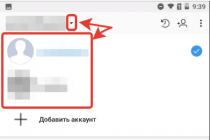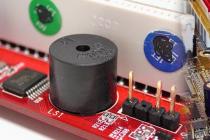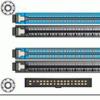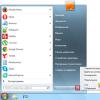This article will discuss what to do if Window 7 does not connect to a WiFi network and. The fact is that although this operating system is more stable than its predecessors, there may still be various errors that need to be corrected manually.
Before moving on to connection problems and their solution, you need to understand what WiFi is and how the technology works. This will allow you to quickly fix some problems.
The fact is that to connect to such a network, you need an access point. Its functions are usually performed by a wireless router. And therefore, first of all, if there are no available connections to the WiFi network in Windows 7, you should pay attention to the router.
As a rule, the reason is precisely in it. But of course, there are other problems as well. So, let's go in order.
Checking the Router
Everything is very simple here. If the laptop does not see available connections, then you should go to the WiFi settings menu of the router and check if the wireless network is enabled. To do this, you need to connect to the router using a regular Internet cable. After that, open a browser (any) and write 192.168.0.1 in the address bar. Press "Enter". Next, a window will appear in which you will be prompted to enter a password and login. As a rule, the default key and login are admin, admin, respectively.
How to easily find out the IP address of a WiFi router: Video
If you have changed these data, then enter your values. Next, we get to the settings menu. We are interested in Network SettingsWireless Network (NetworkWireless). In the wireless network settings, you need to check the box next to the item “Enable wireless network” (Enable Wireless Router Radio). Everything, this completes the router setup. And if Windows 7 problems with WiFi still remain in the laptop, then you should proceed to setting up the operating system.
Why does the computer not see available wireless networks
There are many reasons for this, as well as solutions. Fortunately, Windows 7 is easy to use and has many options for diagnosing and fixing various problems. But we will consider only the most common ones.
The first step is to check the status of your WiFi connection. To do this, you need to open the Network Sharing Center. To do this, click on the network icon in the tray and select "Network and Sharing Center" in the window that appears.
A menu will open in which all settings related to the network are made. Here we are interested in the item "Change adapter settings". In the window that opens, you need to find a shortcut that has the name "Wireless Network Connection". If this connection is greyed out, it means that it is disabled. To enable it, right-click on it and select "Enable".
Windows 7 won't connect to Wi-Fi: Video
Wireless network icon not showing in tray
Often users ask the question, what to do if the WiFi icon is not displayed in the tray in Windows 7? This can only mean one thing - the wireless module is turned off or not working. Wi-Fi activation occurs, as a rule, using the Fn key combination + adapter power button. On different laptops, this button may be located in different places.
For example, on Asus laptops, this is a combination of Fn + F2, on Lenovo - Fn + F5. The WiFi power button itself is indicated by the corresponding image. In addition, on some models, a separate key is provided to activate the wireless connection module. In that case, just click it.
So, after turning on the wireless adapter, Windows 7 should automatically start searching for available networks. If this did not happen, and the tray icon did not appear, then you should check the correct operation of the drivers.
What to do if a laptop with Windows 7 does not see Wi-Fi: Video
Checking Drivers
You can check the software in Windows 7 in the task manager.
You can launch it by clicking on the "My Computer" shortcut, which can be found on the desktop, in the start menu or in Windows Explorer, with the right mouse button. In the window that appears, click "Properties". Next, a menu will open in which you need to open the "Device Manager".
In the window that appears, we are interested in network adapters. If you did not find this, then there are no drivers for the device and you need to install a driver for this module. If, however, such an item exists, then open it. Typically, a wireless adapter is called a Wireless Network Adapter. Also, the device may be indicated by an exclamation mark. This indicates that the driver is not working properly and needs to be updated or reinstalled.
It is very easy to do this. As a rule, a laptop comes with a special disk that contains all the necessary programs and drivers. If there is no such disk, do not rush to get upset. The necessary software can always be downloaded from the Internet, as manufacturers have taken care of supporting their customers.
To do this, find the official website of the manufacturer of your laptop and write the exact name of the laptop (exact model) in the search. Next, you can download drivers for Wi-Fi and install them. It is worth noting that it is not recommended to install software downloaded from third-party sources, as such drivers can be unstable, and sometimes even pose a threat to the integrity of the system.
How to reinstall WiFi driver: Video
It is also important to know that sometimes, even with the driver installed, the adapter cannot be turned on, as additional keyboard functions are used for this. This means that along with the software for the network adapter, you should also download the driver for the keyboard, as well as the recommended utility for managing the wireless module.
The computer does not see the router - first of all we look at the cable. You need a full-fledged patch cord. The twisted pairs of crossover transceivers are crossed. Today it is difficult to find the wrong option. However, there were times when there was an influx of people who wanted to connect 2 PCs directly. Here the factor of the features of the construction of the Ethernet ports of the router and the computer appears - they are mirrored ...
There were curious cases: ping passes, the PC does not see the network. Early versions of Microsoft operating systems (XP, 7) constantly had to be rebooted. Windows 10 is devoid of this drawback. By the way, open the command line, type ping 192.168.0.1 (the numbers indicate the IP address of the router, sometimes the values \u200b\u200bare different: 192.168.1.1, 192.168.10.1 ...).
Perfect option
Try connecting another device. Was Asus, became Zyxel. Quickly locate the source of the problem:
- Cord.
- Router.
- External causes (attack by hackers, hacking attempt).
Change cable
Change the cable immediately. The problem is in the wire. The vein broke off, or the patch is incorrect, incomplete. They produce cables where only a part of the clamped pins is present. Early network protocols sometimes took amazing liberties. The system is fully operational, but backward compatibility is lost.
- Get a good cable.
- Make a connection.

Sees the network, but the address of the admin panel is unavailable? Two options:
- Someone changed the IP address of the router by setting up the hardware. Then, via Wi-Fi, the combination of numbers is also not available. Using a wireless connection, check the current IP address.
- A hacker attack is underway. Unplug the cord, reboot.
Reboot hardware
Routers hang from time to time. Sometimes Wi-Fi works. The reason is the same. The Internet breeds hackers every day. Probably TP-Link, or a laptop through a cable, was attacked. Even if the functionality is restored, it is recommended to perform a hard reset of the device. Then check "doctor web smokes".
Antivirus
Anticipating a hard reset, download an antivirus.
- Open a search engine.
- Type "doctor web smokes".
- Download the utility.
- Disconnect the cable.
- Run a check.
- Destroy the found threats.

Let's consider a typical example. Forum user f1comp complains: TP-Link router, laptop works fine (including Wi-Fi, Ethernet), connected PC receives an IP address like 169.154.x.x, refuses to recognize equipment. A typical case of infection. Immediately download the antivirus in any way, perform a hard reset, heal, reconfigure. The problem is exacerbated by the slow response of antivirus vendors. Fresh infection is practically invulnerable, take comfort in the example of Red October.
Hard reset
- Inspect the case of the router, looking for a recessed miniature (2-4 mm in diameter) button labeled Reset.
- Take a ballpoint pen or paper clip.
- Push the sting inward, holding the key pressed for 3-5 seconds.
- Check the connection.
If the router is still not detected on the computer, perform the WAN settings via Wi-Fi. There is a high possibility of cable failure.
After performing a hard reset, reconfigure the equipment.
Unsuccessful update
Forum users described an unusual case. The admin panel asked me to update the firmware. The user agreed. However, impatience failed. Tired of waiting, the user turned off the power.

After loading it turned out: the wired interface is not available. Although the wifi regularly gives the panel. A great example of irreversible damage to equipment. Why irrevocable? Router manufacturers prohibit over-the-air updates. Since the cable has stopped working, further actions become mysteriously unpredictable.
This is interesting! Operating systems Windows often break, try the user to hurry up by turning off the power. Nonsense. The first PCs rebooted easily. Consider the gift of the router manufacturers as another exercise in patience.
Unlikely Causes
In our memory, D-Link stubbornly refuses to break. Computers are also very reliable. However, there are authors who claim: the iron has broken!
- LAN card.
- Motherboard.
- Brain… PC.
The probability is extremely low. The craftsmen, however, provide one more piece of advice ... check the drivers. The ability to surf the Internet while simultaneously refusing to get in touch with the Rostelecom router makes such arguments ridiculous. Recall the stubborn location of Device Manager:
- Win + R (launches the Run tool).
Select the Ethernet network card, right click, select "update drivers".
This is a very common problem, given that many Internet users are still using desktop computers. Naturally, most often, after the appearance of a Wi-Fi router in the house, they try to connect a desktop stationary computer to a router network cable(aka network cable, ethernet). Fortunately, most modern Wi-Fi routers have two or more LAN ports, usually marked in yellow. Actually, they are designed to connect devices to the Internet via cable. With such a connection, unforeseen problems may occur, especially if the user has interfered with the network settings of the computer. Also, if everything works on Wi-Fi, then it makes no sense to sin on the router settings. The reasons that computer does not see the router on the cable, not so much. How to solve this problem, read below.The computer does not see the router via cable, but everything works via Wi-Fi
We list the most likely causes on which a desktop stationary computer does not see the Internet via cable through a router.Physical problems:
- Router port not working
- Network cable not working
- Computer port not working
Software problems:
- Programmatically disabled network card
- Incorrect operation of the computer's network card driver
- Connection blocking by antivirus
- Incorrect wireless network settings
Physical problems
If devices connected via Wi-Fi also do not work for you, then obviously the reason must be sought either on the side of the Internet provider, or in the router itself. First of all, you should call the technical support service of the company providing you with the Internet. After making sure that there are no problems on the provider's side, you can proceed to further verification. Pay attention to the indicator lights on your Wi-Fi router. About a non-working router, both the absence of an indication at all and the glow of only the power indicator light (Power) can indicate.If more than one indicator light is on on the router, you can continue the test. Each indicator light is labeled with an icon that indicates its purpose. For example, the "Power" icon is known to everyone and is used everywhere, and the Wi-Fi icon is also generally understood. The numbers indicate the operation indicators of the LAN ports, these ports are used to connect the router to computers, smart TVs, etc. If there is electrical activity in the network cable connected to the LAN port of the router, then the corresponding indicator will give light signals.
The absence of a physical connection can be indicated if you are connected to the router with a network cable, and the indicator light of the corresponding port on the router is off. Try switching the cable to a different LAN port on the router. It happens that one LAN router port not working(burned out), but the overall performance of the router is preserved. If, and this did not change the situation, then the reason is not in the burnt connector.
The next step is to check the LAN cable itself (network cable). Plug both ends of the cable into the LAN connectors of the router for a few seconds. It will not work to check the quality of the cable connection, however, the indicators will not light up if network cable not working. By the way, this method of connecting the cable should only be used to check its performance, as this leads to the router freezing as a result of "loopback".
If, having "looped" the cable, we saw that the indicators of the corresponding ports of the router finally lit up, then suspicion falls on your computer itself.
First of all, on the computer, you should check if the LAN connection is disabled ( network card disabled). Take for example Windows XP, 7, 8, 10.
Path for XP
Start - Control Panel - Network Connections - Local Area Connection.
Path for Windows 7, 8, 10
Start ("Settings" for Windows 8) - Control Panel - Network and Sharing Center - Change adapter settings - Local Area Connection.
The LAN connection may turn itself off when there is no Internet connection, if such an option is selected in the power settings management. Moreover, you may not find a local network connection at all in the specified location, this indicates the need to install drivers on the network card.
If a red X is drawn on the LAN connection, then computer port not working, considering previous checks.
Software problems
If the indicator lights are on, corresponding to the connected LAN cables, then a physical connection is present, and the problem should be sought in the computer settings or incorrect software operation.In order to exclude incorrect operation of the network card driver, go to device manager and see how the network card works. It is possible that there are errors in her work. In this case, you can update the network card driver.
In order to exclude connection blocked by antivirus turn it off for a while and try to go online.
The last and one of the most important checks is to check the automatic acquisition of an IP address in order to exclude incorrect wireless network settings.
For Windows XP, click "Start", "Control Panel", "Network Connections", find the icon "Local Area Connection" ("Wireless Network Connection"), right-click on the icon, select "Properties" in the drop-down menu , in the window that opens, select "Internet Protocol TCP / IP" in the list so that the line is highlighted in color, and click the "Properties" button under the list. In the window that opens, make sure that "Obtain an IP address automatically" and "Obtain DNS server address automatically" are selected, if not, then select.
For Windows 7,8,10, click "Start" (or the "Settings" gear for 8), "Control Panel", "Network and Internet", "Network and Sharing Center", "Change adapter settings" find the icon "Local Area Connection" ("Wireless Network Connection"), right-click on the icon, select "Properties" in the drop-down menu, select "Internet Protocol version 4 (TCP / IPv4)" in the list that opens, so that the line is highlighted in color, and click the "Properties" button under the list. In the window that opens, make sure that "Obtain an IP address automatically" and "Obtain DNS server address automatically" are selected, if not, then select.
At least one of the listed recipes should solve your problem. If the problem persists, contact a specialist. As a rule, the same service centers that repair computers do this. Still, I hope that you were able to solve your problems, with little bloodshed, with the help of this article.
A fairly common problem, especially common after some changes: reinstalling the operating system, replacing the router, updating firmware, etc. Sometimes, finding the cause is not easy enough, even for an experienced master.
In this short article, I would like to dwell on a couple of cases due to which, most often, the laptop does not connect via Wi-Fi. I recommend that you familiarize yourself with them and try to restore the network on your own before turning to outside help. By the way, if it says “without access to the Internet” (and the yellow sign is on) - then you better look.
1. Reason #1 - Wrong/Missing Driver
A very common reason why a laptop does not connect via Wi-Fi. Most often, the following picture appears before you (if you look in the lower right corner):
![]()
No connections available. The network is crossed out with a red cross.
After all, as it happens: the user downloaded a new Windows OS, burned it to disk, copied all his important data, reinstalled the OS, and installed the drivers that used to be ...
The fact is that drivers that worked in Windows XP may not work in Windows 7, those that worked in Windows 7 may refuse to work in Windows 8.
Therefore, if you are updating the OS, and indeed, if Wi-Fi does not work, first of all check whether you have the drivers, whether they were downloaded from the official site. Anyway, I recommend reinstalling them and watching the reaction of the laptop.
How to check if there is a driver in the system?
Very simple. Go to "my computer", then right-click anywhere in the window and select "properties" in the pop-up window. Further, on the left, there will be a link "Device Manager". By the way, you can also open it from the control panel, through the built-in search.
Here we are most interested in the tab with network adapters. Look carefully if you have a wireless network adapter, as in the picture below (of course, you will have your own adapter model).

It is also worth paying attention to the fact that there should not be any exclamation marks or red crosses - which indicates problems with the driver, that it may not work correctly. If everything is fine - it should be displayed as in the picture above.
Where is the best place to get a driver?
It is best to download it from the official website of the manufacturer. Also, usually, instead of with a laptop, native drivers come, you can use them.
Even if you have native drivers installed and the Wi-Fi network does not work, I recommend trying to reinstall them by downloading them from the official website of the laptop manufacturer.
Important notes when choosing a laptop driver
1) In their name, most likely (99.8%), there should be the word " wireless«.
2) Correctly determine the type of network adapter, there are several of them: Broadcom, Intel, Atheros. Usually, on the manufacturer's website, even in a specific laptop model, there may be several versions of drivers. To know exactly which one you need, use the utility.

The utility perfectly determined what equipment is installed in the laptop. You don't need to install any settings, just run it.
H several sites of popular manufacturers:
Acer: http://www.acer.ru/ac/ru/RU/content/home
HP: http://www8.hp.com/en/en/home.html
Asus: http://www.asus.com/en/
One more thing! The driver can be found and installed automatically. This is described in the article. I recommend to take a look.
2. Reason #2 - Is Wi-Fi turned on?
Very often you have to watch how the user tries to look for the causes of breakdowns where there are none ...
Most laptop models have an LED indicator on the case that signals Wi-Fi operation. So, it must be on fire. To turn it on, there are special functional buttons, the purpose of which is indicated in the product passport.
For example, on Acer laptops, Wi-Fi is enabled by pressing the Fn + F3 buttons.
You can do it differently.
Go to "control Panel" your Windows OS, then the "network and internet" tab, then " network and sharing center", and finally -" Change adapter settings«.
Here we are interested in the wireless connection icon. It should not be gray and colorless, as in the picture below. If the wireless network icon is colorless, then right-click on it and click " enable".

You will immediately notice that even if it does not join the Internet, it will become colored (see below). This signals that the laptop adapter has worked and it can connect via Wi-Fi.
3. Reason #3 - Incorrect Settings
It often happens that the laptop cannot connect to the network due to a changed password or router settings. This can happen through no fault of the user. For example, the router settings may be lost when the power is turned off during its intensive work.
1) Checking settings in Windows
First, pay attention to the tray icon. If there is no red cross on it, then there are available connections and you can try to join them.

We click on the icon and a window should appear in front of us with all the Wi-Fi networks that the laptop has found. Select your network and click Connect. We will be asked to enter a password, if it is correct, then the laptop should connect via Wi-Fi.

2) Checking the router settings
If it is impossible to connect to the Wi-Fi network, and Windows reports an incorrect password, go to the router settings and change the default settings.
In order to enter the settings of the router, go to " http://192.168.1.1/" (No quotes). Usually, this address is used by default. The default password and login, most often, " admin" (in small letters without quotes).
Next, change the settings in accordance with your provider settings and router model (if they go wrong). In this part, it is difficult to give some advice, a more extensive article on creating a local Wi-Fi network at home.
Important! It happens that the router does not connect to the Internet automatically. Go to its settings and check if it is trying to connect, and if not, try connecting to the network manually. This error often happens on TrendNet brand routers (at least it used to be on some models, which I personally encountered).
4. If all else fails...
If you've tried everything and nothing helps...
I will give two tips that help me personally.
1) From time to time, for reasons unknown to me, the Wi-Fi network is turned off. The symptoms are different every time: sometimes it says there is no connection, sometimes the tray icon lights up as it should, but there is still no network ...
A 2-step recipe helps to quickly restore a Wi-Fi network:
1. I disconnect the power supply of the router from the network for 10-15 seconds. Then I turn it on again.
2. I restart the computer.
After that, oddly enough, the Wi-Fi network, and with it the Internet, work as expected. Why and because of what this is happening - I don’t know, I don’t want to dig either, somehow. this happens quite rarely. If you know why, please share in the comments.
2) It was once that it was not at all clear how to turn on Wi-Fi - the laptop does not respond to the function keys (Fn + F3) - the LED is off, and the tray icon says that “there are no connections available” (moreover, it does not find Not one). What to do?
I tried a bunch of ways, I already wanted to reinstall the system with all the drivers. But I tried to diagnose the wireless adapter. And what would you think - he diagnosed the problem and recommended to fix it "reset settings and turn on the network", which I agreed with. After a few seconds, the network started working ... I recommend trying it.
Unfortunately, many of us have encountered the problem when the laptop stops finding the wireless network, which creates a noticeable inconvenience. Given that the laptop can be used outside the home, the user may be left without the Internet at all. There can be many reasons for this little pleasant moment. But, as a rule, the problem is technical, or in the wrong operation of the software. To understand how to deal with the problem, we will analyze it in more detail.
In order to understand the causes of the problem and understand why the laptop does not find a WiFi router or home WiFi network, you need to know what WiFi is and understand how this wireless communication system works.
WiFi is the same local network, only without the need for cabling. Connection to the network occurs through a signal that is transmitted via radio waves. Such a system has gained popularity not so long ago. Even a dozen years ago, no one knew about it, and the signal distance was much less. To be precise, the signal can be sent to a distance equal to 100 km.
In addition, WiFi is a registered trademark that is being developed very actively. In 2014, data transfer rates over WiFi should increase to several Gbps.
To put it simply, now this method of connecting to the network is very popular. Almost every laptop has a built-in sensor that allows you to use a wireless network. At stops, in cafes or any other public places, the owners install free access points, which increases the comfort level of the establishment or public place.
The main reasons for the lack of WiFi
As mentioned above, the main reasons can be divided into technical and software. In the case of technical ones, the laptop owner will most likely have to contact a service center and spend money on repairing it. In the best case, deal with the cause of the poor performance of the router.
WiFi on laptop and router
It’s worth starting with the very basics that can be forgotten due to haste or inattention.

Make sure the receiving antenna is on. If the WiFi button does not work, then the problem is obvious. Not all laptop models have this switch, but some do. It looks, most often, not in the form of a button, but in the form of a latch. In other words, it depends on the manufacturer. With the switch, there may be a signature or an image of the antenna, which stands for WiFi.
If there is no such button on the laptop model, then you need to pay attention to the bottom panel of the operating system, to the icon next to the time. The image should show whether the wireless connection is currently active.
It is possible that this icon is not on the panel next to the time.
To check the activity without the help of this icon, you need to:

Checking available networks
The next thing to do is to check the available networks. Perhaps the router simply does not reach the laptop antenna and for this reason it is impossible to connect to the network.
For this you need:
- click on the network icon in the lower right corner, on the bottom panel, next to the time.
- Select "Connect to a network" and select the desired access point. Most likely, there will be more than one access point, since you can see neighboring or some other routers. But, in most cases, a password is put on the access point, thus protecting it from unauthorized users.
Video: What to do if ASUS laptop cannot find Wi-Fi
The laptop does not see the WiFi network: the main reasons
Why does the laptop not see the WiFi network? Perhaps the solution to the problem is right in front of you and takes only five seconds of your time. But there are also more severe cases. Consider the most common options.
router
Make sure the router is turned on. Its operation can be easily identified by the indicator lights. After connecting, look at the corresponding icons in the instructions for the router and determine if the wireless connection is active.

If the router does not respond at all, then the problem is purely technical. In this situation, it is worth looking for a problem in the wires, the power supply, or carrying the router for repair. As a rule, it is easier to replace the router with a new one than to give it to service centers for inspection.
Drivers
As you know, any equipment requires software that guarantees stable operation. If the laptop does not detect WiFi, then it is worth checking the drivers. Even if they are installed, it is recommended to update them.
You can check the drivers through the control panel. In the "device manager" section there is a line "network adapters", which should contain the name of the router, if the problem is in the drivers. Right click on it and see the driver version. Compare it with the real version, which can be found on the Internet.

If the version is outdated, then download the new one and install it. It is best to download from official sources. Drivers for equipment are distributed by developers for free, and it is not worth risking the "health" of your operating system in vain.
signal distance
If, after searching for a network, the answer appears: “No connections available” - think about the signal. In apartments, this option is not very relevant, since modern routers have a strong signal and spread it far enough. But in private homes or other places where the distance can be quite large, the signal simply may not reach the laptop. Therefore, do not be surprised if the Internet suddenly disappeared when you were walking around the house or yard.
Mac address
There are situations when it was possible to connect, but the router does not see the Internet through my WiFi or stopped seeing it. When using the services of some providers, the user cannot just change the network adapter, as the Mac address changes.
The Mac address is written on each router and the user just needs to call the operator to bind the new address to replace the old one. You may be asked to dictate it in full, or to clarify only the last few values of the entire number.
Antivirus or third party programs
Third-party programs installed on a laptop may conflict with drivers or interfere correctly with establishing an Internet connection, which often happens when the device sees wifi but does not connect. In addition, sometimes antiviruses interfere with creating a connection. If possible, it is better to try to connect the Internet without a router first. If everything is fine, then the programs are not to blame.
In addition to the above, there can be a lot of reasons. Basically, a variety of reasons are due to malfunctions in the operating system. Therefore, if all else fails, try reinstalling your operating system. Perhaps all the problems come from here.
The laptop does not see the WIFI network on Windows7 / on Windows 8 / on WindowsXP
For those who are wondering why the laptop does not see wifi Windows 7, first of all, you need to try manually turning on the wireless network.
For this you need:

In Windows 8, activity is checked through the "PC Settings" item. Next, you need to select the line "wireless" and move the slider on the right side of the menu to the "On" state.
The wireless network when using Windows XP does not require manual activation and, as a rule, is connected like Windows 7. It is enough to activate it through the control panel or through the wireless icon through the bottom panel of the system.
Video: how to create and configure a WI-FI network
How to set up a wireless network
For comfortable use of the network, some users resort to settings. Usually, standard settings are enough, but if you wish, you can delve into your personal account. It is through the personal account that the parameters are changed.
The login and password are specified by the manufacturers of the router, and you can find this data in the instructions. There is also an address that will take you to your personal account. It is best to replace the standard data so that no one can use it.
All other settings are made on the laptop itself, and they are set using the network control center.
WiFi without internet due to Windows
There are rare cases when the operating system itself does not want to detect a wireless connection and shows that there is no external network at all. This option may be when using non-licensed operating systems. Some prefer to use amateur assemblies, which do not load the system so much and allow you to squeeze more out of iron.

Another reason may be a "blockage" of the system. System folders, over time, become clogged with unnecessary files, and if you do not defragment, the processor will be loaded more and more. Antiviruses also cannot keep a laptop clean forever.
In any case, all problems with the OS are solved by a simple reinstallation. After reinstalling Windows, everything should work. Thus, the solution to the problem lies only in the operability of the router, WiFi on the laptop, or the availability of the necessary software. Subject to these points, WiFi will not present difficulties, and will delight the user with stable operation.














